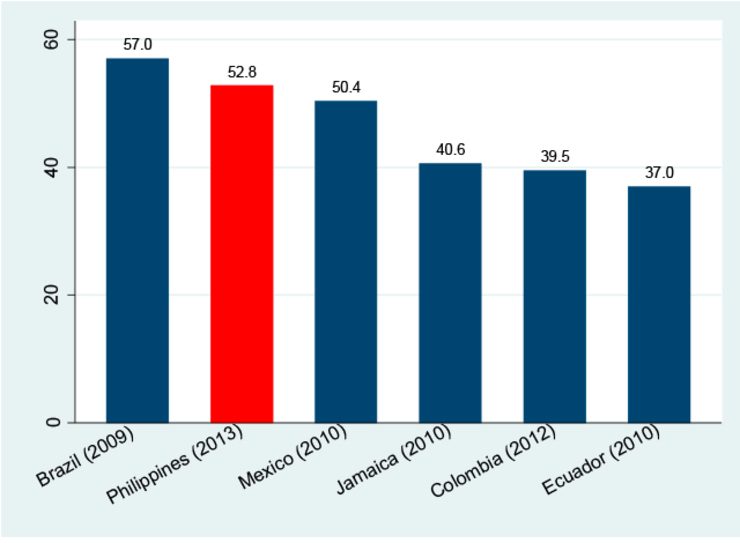SUMMARY
This is AI generated summarization, which may have errors. For context, always refer to the full article.

The Pantawid Pamilyang Pilipino Program (4Ps), the government’s conditional cash transfer (CCT), has come into scrutiny by legislators with significant resources proposed for it next year. From P4 million in 2007 to support 6,000 households, the 2014 budget was P62.6 billion to assist 4 million households, and will even grow next year with the extension of support to children in high school.
According to the World Bank staff, Pantawid has become the third largest CCT program globally, next only to Brazil (8.8 million households) and Mexico (6.5 million households). The CCT should certainly be scrutinized, and so with every program involving public funds: everyone should ask about the value of each peso spent in government programs and projects.
In a previous article, I pointed out that poverty incidence has not changed, even with the CCT, but not to the fault of Pantawid since all things have not been equal. Climate disasters and other factors put nearly-poor households at risk of falling into poverty. At a Department of Social Welfare and Development (DSWD) forum held last November 17, it was suggested that poverty would have further worsened without Pantawid. Using data from the 2013 Annual Poverty Indicator Survey (APIS), conducted by the Philippine Statistics Authority (PSA), the poverty rate (of 25%) could be as much 26.4% without Pantawid. Even the extreme poverty rate (of 11.1%), the proportion of Pinoys whose income is less than needs for food, would be 1.4 percentage points higher without Pantawid (12.5%) in place.
| National | Among Pantawid Beneficiaries | |||
| Without Pantawid | With Pantawid | Without Pantawid | With Pantawid | |
| Poverty Rate | 26.4% | 25.0% | 64.5% | 58.1% |
| Extreme Poverty Rate | 12.5% | 11.1% | 35.3% | 28.7% |
Note: Estimates generated by World Bank Staff using data from national household surveys conducted by PSA, as presented in DSWD forum on Pantawid Pamilya 2nd Wave Impact Evaluation, Nov 14, 2014.
Among CCT beneficiaries, the increase in poverty rate without Pantawid is even higher.
Poverty among beneficiaries (at 58.1%) would be 6.4 percentage points higher (64.5%) without the CCT. Doesn’t this suggest that some CCT households are not “poor”? Certainly, but independent evaluation by the Social Weather Stations shows that most of these non-poor beneficiaries are nearly-poor.
It must be understood that government officially defines poor according to income data and poverty thresholds. The PSA generates income data through a meticulous process of asking detailed information on income through surveys. The DSWD, through their Listahanan, on the other hand, obtains information on facilities (such as electricity, toilets, walls, roofs) and assets (such as refrigerators, television sets, and the like), and on the basis of a statistical model estimates household income.
There are errors in identifying poor households (when a non-poor household is thought to be poor, or a poor household is tagged as non-poor), but DSWD has a process for delisting the non-poor, and also for having the poor who are not in its list to be enlisted, subject to verification.
Further, the World Bank estimates that more than four fifths (82%) of Pantawid beneficiaries are from the bottom 40 percent of income distribution, and more than half (53%) are from the bottom 20 percent. Figure 1 shows that when Pantawid is compared in targeting accuracy with other CCTs, the DSWD program performs better than all CCTs with a large coverage in the population (of more than 15%), except for that of Brazil.

Another measure of poverty is the poverty gap index representing the average amount of income required by the poor to reach the poverty line, in relation to the poverty line. APIS 2013 data shows that Pantawid has increased the income of beneficiaries so that they have moved closer to the poverty line: per peso cash grant, the poverty gap has been reduced by 61 centavos.
In 2013, Pantawid beneficiary families received an average of P1,407 of monthly cash grants, if they sent their 3 beneficiary children to school, and received health services for their household members. Without the cash grants, these families had an average per capita income of P13,293, whereas the poverty line per person was P19,262. Thus, the amounts given will not really help them cross the poverty line, but are only truly “Pantawid.” About half of cash grants are used for food, a quarter (25%) on educated-related expenses, while 7% is used on health, and close to nothing is used for recreation or alcohol.
The PSA estimated that in 2012, the “income gap” of the poor, i.e. the total amount required for all poor persons to cross the poverty line (assuming we could identify them and give them just what they needed, without even considering the costs of identifying them) was P136.6 billion, whereas the full CCT budget covered P39.4 billion.
So while the CCT budget is large, when you drill to the beneficiaries, this is still not enough to help them get out of poverty.
The amounts have even been eroded by inflation: in the pilot program in 2006, maximum cash grants were a fourth (23%) of household income, but by 2013, this went down to less than a tenth (7%). Once children beneficiaries have finished schooling and join the labor market, we expect the households to have better incomes, but this won’t happen now.
Not the best way?
Finally, some opine that giving money to the poor is not the best way to help since the poor may become dependent on that assistance.
A study by Dr. Aniceto Orbeta and Dr. Vicente Paqueo, two colleagues at PIDS, with Dr. Christopher Spohr of ADB suggests that Pantawid has actually increased the desire for work of the household head and the spouse, as well as all adult members 18 years and above, and middle-aged workers 35-54 years old. They point out that “parents work to compensate for loss of income from children who attend school. When people publicly recognize the importance of education, families are convinced to keep their children in school. Households also respond by exerting more effort.”
In terms of child labor, Orbeta, Paqueo and Spohr show that Pantawid also has significantly reduced hours of work for pay of elementary school-aged children 6 to 11 years old, although Pantawid did not significantly affect the incidence of child labor.
In an independent study, other colleagues at PIDS, namely, Dr. Celia Reyes and Mr. Christian Mina, estimated using APIS 2011 that Pantawid increased school participation of children aged 6-14 by 3 to 4.6 percentage points. Around 96.3 percent of children of 4Ps families attend school, while among “matched non-4Ps” families, i.e. households similar to Pantawid beneficiaries who did not get cash grants, the school participation rate ranged from 91.7 to 93.3 percent. Increasing school attendance has been the main objective of the program, and it is worth noting that the program has achieved outcomes that it was designed for.
What deserves reexamination
In a paper on inclusive growth that I helped prepare for the Asian Development Bank (ADB), it can be seen that the proportion of the youth (aged 15–24) in the Philippines (see Table 2) with less than 4 Years of schooling (called education poverty rate) had hardly changed from 5.3% in 1993 to 4.9% in 2008. The Philippines has had little improvements in the average years of schooling among young before government expanded the coverage of Pantawid.
In addition, data in 2008 shows that prior to Pantawid, the share of our youth with less than 4 years of schooling among the poor (19.0%) was as much as four times the national average (5.3%).
| Extreme Education Poverty Rate | Education Poverty Rate | |||
| 1993 | 2008 | 1993 | 2008 | |
| Lowest Quintile | 7.2 | 19.0 | 7.2 | 18.8 |
| Highest Quintile | 0.6 | 1.2 | 0.3 | 0.7 |
| Rural | 3.0 | 8.5 | 3.2 | 7.9 |
| Urban | 1.0 | 2.7 | 0.7 | 2.3 |
| Male | 2.1 | 6.7 | 2.2 | 6.5 |
| Female | 1.7 | 3.9 | 1.6 | 3.3 |
| National | 1.9 | 5.3 | 1.9 | 4.9 |
Note: Estimates prepared by ADB staff using data from 1993 and 2008 National Demographic Health Survey (conducted by PSA)
With the conduct of Pantawid, we would expect more and more returns to these investments in human capital. The CCT was premised on the idea that the poor have more opportunity costs sending their children to school, and that people respond to incentives.
There is growing evidence showing positive outcomes for Pantawid. In the long run, we would expect to see even more evidence of impact on poverty conditions in the country.
What deserves reexamination in Pantawid is the uniform cash grant, which has eroded in value. Opportunity costs for sending children to school and keeping them there is not uniform: for boys (as against girls), for rural children (as against urban kids), and also for older kids, the costs are higher, so incentives for these children must also be higher. – Rappler.com
Dr. Jose Ramon “Toots” Albert is a professional statistician who has written on poverty measurement, education statistics, agricultural statistics, climate change, macro prudential monitoring, survey design, data mining, and statistical analysis of missing data. He is a Senior Research Fellow of the government’s think tank Philippine Institute for Development Studies, and the president of the country’s professional society of data producers, users and analysts, the Philippine Statistical Association, Inc. for 2014-2015. From 2012-2014, he served as Secretary General of the now defunct National Statistical Coordination Board (NSCB). He is also a member of the United Nations Global Pulse’s Data Privacy Advisory Group.
Add a comment
How does this make you feel?
There are no comments yet. Add your comment to start the conversation.